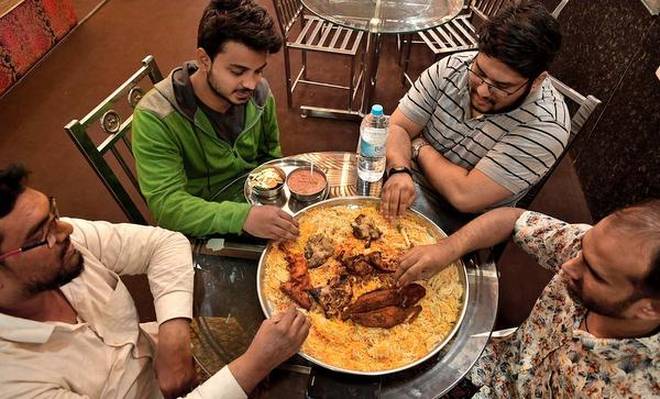Hyderabad, TELANGANA :

Restaurateurs in Barkas and Yerrakunta suburbs arrived here from Hadhramaut in Yemen over two centuries ago
A 20-minute drive south of Charminar is all it takes to wonder whether one has teleported oneself to a west Asian country. For, once in Barkas and Yerrakunta suburbs, one is greeted by exotic signage in Arabic on restaurants like Mataam al Arabi, Al Saud Bait al Mandi and Al Khaleej serving the Arabian delicacy Mandi. And the business is booming.
The connection is clear. The two neighbourhoods are home to those who arrived here from Hadhramaut in Yemen over two centuries ago. Several of these restaurateurs continue to bear Arabian tribal affiliations. While one eatery is owned by those from the Bin Ziyad tribe, another belongs to the Nahdis. There are dozens of tribes as are the restaurants run by them.
Abdul Raheem Yamani, proprietor of Real Arabian Dhaba, pegs the number of Mandi restaurants along the six-km stretch that connects Barkas to Shaheen Nagar along the Srisailam highway at approximately 35. “This is the reason why the highway has a new moniker – Mandi Road,” he says.
The restaurateurs say that the spurt in the number of Mandi restaurants began in 2011 when the Arab community realised that it was a profitable business. Restaurants started mushrooming not just along the margins of the main thoroughfares, but in the by-lanes of Barkas.
With diners converging from across the city, observers say that while traditional Hyderabadi biryani continues to be famous, Mandi is giving it a run for money.
One of the first Mandi restaurants in the area is Mataam al Arabi. Its proprietor Abdullah Bashaadi says the dish is a combination of large chunks of mutton and rice garnished with dry fruits.
The 38 year old recounts that he began the business in 2010 soon after returning from the Haj. “We were served Mandi during the pilgrimage. All ate from the same large thaala sitting on the floor. That is when I struck upon the idea to start a Mandi restaurant,” Mr. Bashaadi says.
The traditional Arabian method of dining—sitting on the floor and eating from the same large dish—has been retained in all the Mandi restaurants.
Like most who trace their ancestry to the Arabian Peninsula, Mr. Bashaadi’s great grandfather Ahmad bin Awad Bashaadi arrived in the city from Hadhramut, Yemen. In fact, noted scholar Omar Khalidi writes in Muslims in the Deccan: A Historical Survey that Hadramis were a part of Afwaj-e-Beqaidah(Irregular Army) of Asaf Jahs. Their numbers swelled so much so that the Diwan, Salar Jung, constituted a separate court, the Qazaat-e-Uroob, for them. Further, two Hadramis served as Commissioners of Police of Hyderabad State.
Taha Quadri, a professional caterer specialising in Arabian cuisine, explains the Mandi variants. The rule of thumb is three parts of mutton to one part of rice. The rice is cooked in the same water that is used to boil the meat. “Mutton can be replaced with fish, chicken and even quail,” he says.
But while diners converge at the Old City from all across Hyderabad, the dish is a hit with the IT crowd of Hitec City. The uptown area of Jubilee Hills has one.
“There was a great demand for the dish in this part of the city which is why we started the restaurant around nine months ago. A majority of our customers are those working in Hitec City,” says Syed Waaris Ali, proprietor of Mandi @ 36.
source: http://www.thehindu.com / The Hindu / Home> News> Cities> Hyderabad / by Syed Mohammed / Hyderabad – January 13th, 2018








